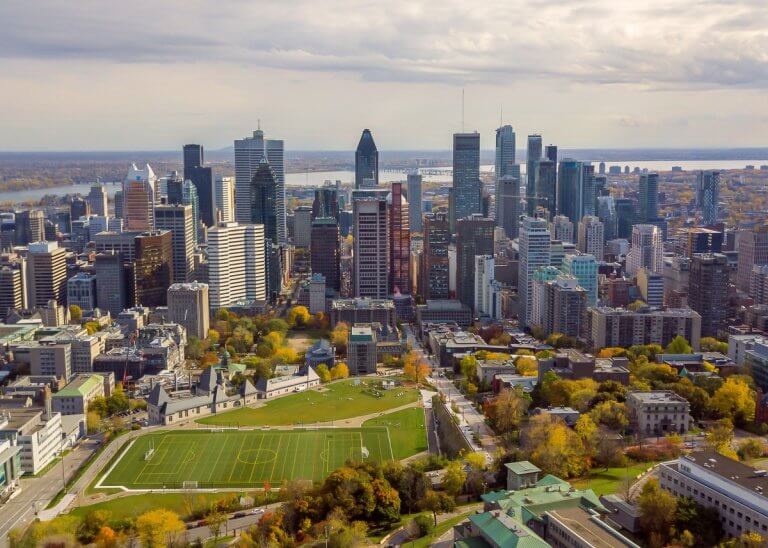
Concordia recently received the Canada Excellence Research Chair (CERC) in Smart, Sustainable and Resilient Cities and Communities. The position comes with CA$10 million in research funding, spread out over seven years. Already, Concordia researchers are responding to the sustainable development imperative, advancing intelligent communities that combine smart technology, integrated building design and community engagement.
While the Faculty of Arts and Science will be traveling to Lyon this fall to discuss the matter of smart cities during Les Entretiens Jacques-Cartier, Professor Greg Nielsen shares his view on the matter below.
What makes a city smart?
Montréal is the second largest University City in Canada and the US. There are 11 post-secondary institutions and four world-class schools with probably well over 200,000 students. Thanks to the student uprising in the Maple Spring of 2012, Montréal has the second-cheapest tuition in Canada after the province of Newfoundland. While Montréal has very smart people and very smart entrepreneurs, none of this is what makes Montreal a smart city.
A smart city maximizes proficiency in public services through digital technologies and communication networks applied to public services such as waste management, transportation, and other commonly shared urban institutions – including applications used by the police and the courts to survey and discipline populations.
This sounds like a perfectly rational evolution for urban development. But we need to consider that smart cities without social responsibility might not be so smart after all. The application of Cloud technology, big data analytics, the internet of things (IoT), artificial intelligence (AI), and other emerging technologies are in their infancy, but are already on the verge of making a major social and economic impact on cities.
Massive data storage and mining from consumer data and social media can construct individual profiles on citizens and non-citizens, potentially determining risky behavior patterns and anticipating criminal activity. But do we want to police neighbourhoods using private data on each citizen or non-citizen? Financial markets and banks are already engaging in IoT and blockchain technologies in a rush to maximize profits, without necessarily considering the kinds of disruptions that might occur in an era of deregulation (remember 2008?).

Source: Concordia University
Social Responsibility: Acts of Urban Citizenship
Contemporary cities in all parts of the world need to foster sustainable citizenships in sectors affecting responsibilities and rights. Wherever a public service or common place is defined in a city (garbage pick-ups, street signs, parks, schools, clinics, squats, community centres), there is a right that is put into place in the form of a law, a regulation, or a rule backed by either civil or penal sanctions.
Wherever there can be an interpretive contradiction in which people stand up to argue that how they’re being represented, or what’s required of them, is unjust, we can call an act of citizenship. Smart cities need carful sociological and anthropological investigation into the multiple pathways leading in and out of the urban commons so engineers, technologists, ‘infrastructuralists’, economists and designers might better determine how they’re structured.
Can socially-responsible smart cities solve social problems brought on by global economic processes that create a series of inequalities and difficult trade-offs? As cities fuse or amalgamate municipalities to gain economic capacities, they risk becoming too large and too symmetrical to maintain safe levels of sociability, transport or environmental sustainability.
Smart non-polluting public transportation can go a long way to solve mobility problems. Electric buses with real time wifi at each stop would be one solution. Metro and light rail moving from one district to another would also help.
But some urban development would seem to be already too far gone to solve difficult problems of democratic deficits with smart city applications. For example, the Los Angeles urban region is made-up of five counties with a total population between 17 and 20 million living in 177 cities within a radius of 14,000 square miles.
The fragmentation and sprawl with increasing population density have moved vastly beyond central political jurisdictions to the point that governments can no longer represent the interests of Los Angeles constituents. The Watt riots in 1966 and the Rodney King “justice riots” in 1996 are examples of the pent-up layers of oppression that can explode.
Smart cities need to find a balance to avoid democratic deficits as new utilities are introduced for waste management, transportation and communications infrastructures. Smart cities that provide open access communication infrastructures can play an important role in creating a common identity out of the diversity of its people, but the key is treating the technologies as public utilities similar to publicly-funded media institutions.

Source: Concordia University
The smart solution for a healthy RICH city would include inner city renewal, mixed density, and the preservation of older neighbourhoods. Cities that plan and help finance inner city areas to be made up of a mixture of artists, immigrants, and GLBTQ communities have the most prosperous economies.
What about the least well-off cities?
Can they get smart and stay socially-responsible? Around the planet, we should expect growth in new megacities with populations of 8 million or more plus several more “hyper cities” of 20 million and more, by 2054.
We need to keep in mind that different citizenship politics and cultures are needed to maintain smart sustainable urban commons. This is true both in northern cities and in the global south, where urban population growth and the variety of illegal or squatter cities increase at a far greater pace. Cities of all kinds and in all parts of the world need to foster sustainable citizenships in sectors affecting responsibilities and rights. In some places you need a water pump, and a sewage system a lot more than wifi, cloud technology, big data analytics, or IoT!
Greg M. Nielsen is a Professor, Sociology and Anthropology and the Co-Director of the Concordia Centre for Broadcasting and Journalism Studies (CCBJS). He teaches and publishes in the areas of social and cultural theory as well as media sociology.
Follow Concordia on Facebook, Twitter, YouTube, Google+, Pinterest, Flickr, Instagram and LinkedIn
Liked this? Then you’ll love…
How Concordia is creating a culture of sustainability through responsibility and innovation
Concordia University: Creating innovation through International Graduate Summer Schools







